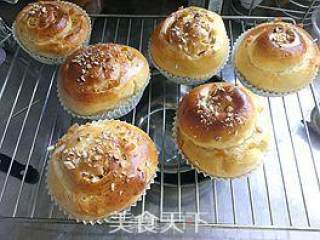Orange Roll
1.
Put all the ingredients in the main ingredients into the bread machine, start the "kneading" program, put in the softened butter and orange zest after the program ends, and start the "kneading" program again
2.
The second "kneading" process is over, take a small piece of dough and slowly stretch it out with both hands. At this time, the transparent film can be pulled out.
3.
Knead this small piece of dough into the large dough again, round the dough and put it back into the bread bucket
4.
Cover the bread bucket with a piece of baking paper and pop some drops of water onto the paper
5.
Cover with a wet towel and cover the bread machine lid to ferment
6.
Ferment the dough until it is twice as big, and poke the dough with the dry flour with your fingers. After the fingers are pulled out, there is no change around the small holes that are made.
7.
Take out the exhaust air, round it up, cover with plastic wrap and relax for 15 minutes
8.
Roll out a rectangle with a length of about 30cm and a width of about 18cm
9.
Sprinkle the candied orange peel evenly after turning it over and flatten it gently with your hands
10.
Roll up from top to bottom, cut into 8 equal parts, put it in a paper mold with the incision facing up, and cover with plastic wrap for secondary fermentation
11.
Ferment again to double the size, and gently poke with your fingers. The pressed pit (see the small pit under the dough in the picture) will not completely bounce back and it will be fermented.
12.
Brush a layer of whole egg liquid evenly on the surface, sprinkle an appropriate amount of almonds, put it in a preheated oven, heat up to 180 degrees, lower the heat to 190 degrees, bake for about 18 minutes, and then move to the grid to cool


Tips:
1. Generally, the first fermentation takes a long time. In order to keep warm and breathe, I always cover a piece of baking paper on the bread bucket, flick some drops of water on it with my fingers, and cover it with a wet towel.
2. Orange zest is the yellow skin of a planed orange. When planing, be careful not to shave off the white part of the orange peel, it will be bitter. Orange juice is used by cutting the orange in half and squeezing out the juice inside.
3. When rolling up at the end, it should be as tight as possible so that it will not loosen when cutting.
4. Don't over-ferment to avoid sour. You can judge whether it is well after the first shot. You can poke the dough with your fingers and dry flour. If the hole does not rebound or collapse, it means that the fermentation is complete. In the second serve, just poke the dough with your fingers (poke in an inconspicuous place) to judge whether it is done well. That means the noodles will not bounce back completely.